Sailing Topics
| Bahamas 2014 | |
| I spent the entire year of 2013 at the Ortega
Yacht Club Marina in Jacksonville, FL. My major project for this year was the
installation of a Quick
Hector Windlass to replace the Lofrans Royal Windlass that
came with the boat when I purchased her in 2000. The
windlass installation didn't really take the entire year.
I pretty much stopped working in July when the high temperature
reached the upper 90s and stayed there until the end of August. I finished the installation in September and was anxious to test the windlass and my installation. A return to the Bahamas seemed to be a good way to test everything. Steve Angst, my good friend and long-time crew wanted to join me for the trip so we planned a departure in mid-January, 2014. |
|
| Jacksonville to Marsh Harbor | |
| Steve joined me in Jacksonville in early January, 2014.
Our departure was intially delayed by the need to have my new
AB Dinghy
repaired. Then the weather kicked in. This was a
few weeks after the infamous Polar Vortex that brought freezing
temperatures to most of the Eastern USA. However the
unusually cold temperatures continued for several weeks after
the dinghy was repaired. Because I have no heat on the boat once we leave the dock we wanted to avoid very low temperatures for the first few days of the trip. Finally on January 26 the forecast low temperature was above 40°F and we headed down the St. John River. Because of the persistent cold temperature we decided to use the AICW for the first part of the trip. The chart on the right shows our path down the AICW to the St. Lucie Inlet and then the crossing of the Florida Strait to the Bahamas. |
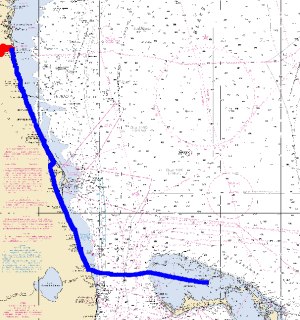 Sarah's Track from the St. John River to Great Sale Cay in the Bahamas |
| Day One: Ortega River to the AICW | |
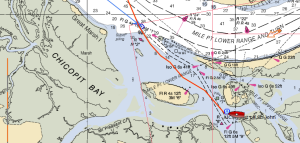 Anchored Just Off the AICW |
So that first day we stopped just inside the AICW off the St. John. |
| This is a fair weather only anchorage. Our main concern was the overnight temperature. However we should have been more concerned about the depth and the tides. I put out too much rode and anchored too close to the shoal on the east side of the anchorage. Overnight we shifted aground when the ebb tide began. We heeled over to almost 25° before the flood brought us back up right. |
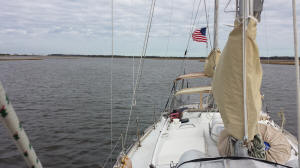 AICW Anchorage Near the St. John River |
| After that embarassing anchor drill we got underway shortly after dawn on a very cold morning. |
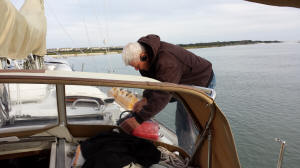 Getting Underway in the Cold |
| Day Two: Mantanzas Inlet | |
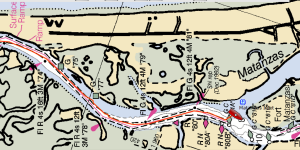 Anchored Near the Mantanzas Inlet |
The next day we passed through St. Augustine and dropped the hook near the Mantanzas Inlet. This inlet has silted in and is no longer open to navigation so we didn't have to worry about any late night or early morning fishing boats going through the anchorage. |
| Day Three: Rockhouse Creek | |
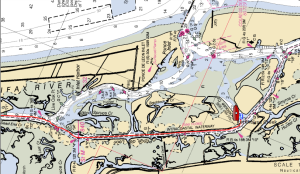 Anchored in Rock House Creek |
The following day we anchored in Rock House Creek near New Smyrna Beach. |
|
This was an early stop and there were only a couple of power
boats in the anchorage. Several more boats anchored in the creek after we arrived. |
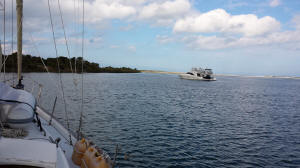 The Rock House Creek Anchorage |
| The next morning we had a lovely sunrise as we got underway. |
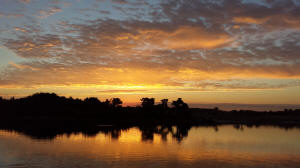 Dawn in Rockhouse Creek |
| We didn't get far before we were stopped by heavy fog in New Smyrna Beach. At times the visibility was less than 100'. We stopped in the AICW and waited for about 2 hours for the fog to lift enough that we could see the channel markers. |
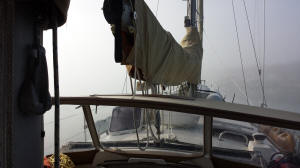 Pea Soup Fog in New Smyrna Beach |
| Day Four to Five: Cocoa | |
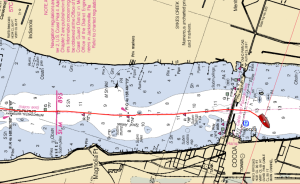 Anchored Off Cocoa, FL |
We had just enough daylight to pass through Daytona Beach and the Mosquito Lagoon. We continued down the Indian River Lagoon to the anchorage off Cocoa, FL. |
| We had cold, but dry weather for the first four days of the trip, but that night in Cocoa the weather turned cold, wet and windy. We decided to stay put in Cocoa until the nasty weather was over. |
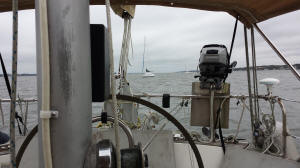 |
| Day Six: Eau Gallie | |
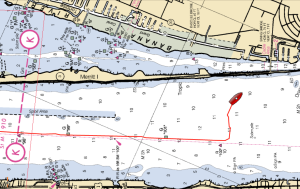 Anchored Opposite Eau Gallie, FL |
After two days in Cocoa it was still raining, but we decided to move a short way down the Indian River to have a shorter trip to Vero Beach the next day. We dropped the anchor near the intersection of the Banana and Indian Rivers. |
| Day Seven to Thirteen: Vero Beach | |
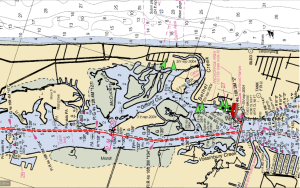 On a Mooring in Vero Beach |
It was a good thing we moved that short distance because the next morning we once again had pea soup fog. We finally got underway around 10:00 AM. |
| That afternoon we picked up a mooring at the Vero Beach Municipal Marina. |
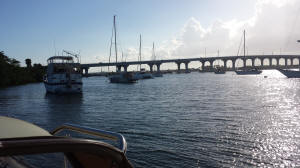 The Mooring Field in Vero Beach |
| By this time the weather was warm and pleasant. We launched the dinghy but discovered the outboard motor would not start. So for the first few days in Vero we were forced to row the dinghy ashore. Once the motor was repaired the oars were put away. |
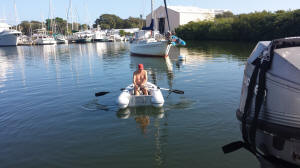 Steve, Rowing the Dinghy in Vero Beach |
| Day Fourteen to Fifteen: Jensen Beach | |
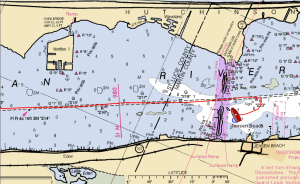 Anchored off Jensen Beach, FL |
We stayed in Vero (AKA Velcro Beach) for nearly a week
running a number of errands using the free bus service. Finally it looked like we might have a weather window to cross the Florida Strait to the Bahamas. We dropped the mooring and headed down the AICW to Ft. Pierce, intending to use that inlet as our departure. By the time we got to the inlet the wind had picked up out of the north and we headed further down the AICW to Jensen Beach and wait for better weather for the crossing. |
| Day Sixteen to Seventeen: Jensen Beach to Great Sale Cay | |
| We stayed two nights anchored off Jensen Beach before we had
good weather for the crossing. I've never used the St. Lucie Inlet, but friends had used it a few weeks earlier and reported that it had just been dredged and there were no problems. We passed one of the dredgers as we headed out through the inlet. |
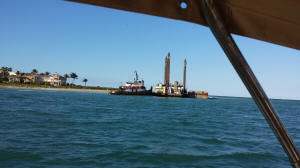 Dredger in the St. Lucie Inlet |
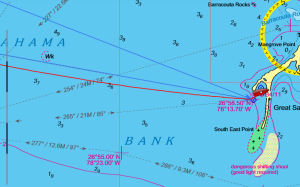 Anchored at Great Sale Cay, The Bahamas |
There was very little wind in the Florida Strait that night,
and we motored across the Gulf Stream and entered the Little
Bahama Bank at the White Sand Ridge around 1:00 AM. We anchored later that day off Great Sale Cay. |
| Day Eighteen to Twenty: Spanish Cay | |
| We would have liked to spend at least another night at Great Sale Cay to catch up on sleep lost durng the overnight passage from Florida. However there was a strong cold front approaching the Bahamas with gale force winds so we got underway the next morning for Spanish Cay. |
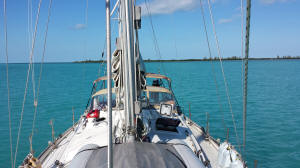 Anchored in Great Sale Cay |
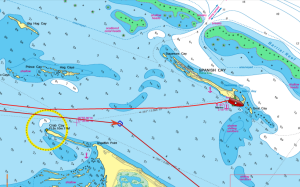 Berthed at Spanish Cay Marina |
We took a berth at the Spanish Cay Marina to wait out the
storm. This marina is not that well protected from NW
winds, but it would be a little more comfortable than an exposed
anchorage. Spanish Cay is also a Port of Entry into The Bahamas and we were able to clear through customs and immigration. |
| Day Twenty-One to Twenty-Five: Green Turtle Cay | |
| We spent three nights at the Spanish Cay Marina waiting for
the storm to blow out, then we moved to Green Turtle Cay. We spent four pleasant days at anchor in White Sound. |
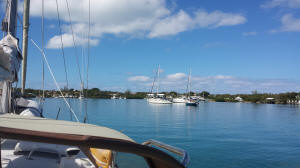 Anchorage and Mooring Field in White Sound, GTC |
| Day Twenty-Six to Twenty-Eight: Man O'War Cay | |
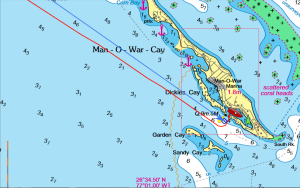 On a Mooring at Man O'War Cay |
Our next stop was Man O'War Cay. We picked up a mooring in Eastern Harbor. |
| In Man O'War Cay we were next to Taia with a young Canadian (by way of Argentina) family I had met that winter in Jacksonville. |
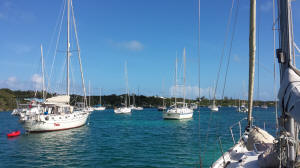 On a Mooring Next to Taia |
| Day Twenty-Nine: Marsh Harbor | |
|
After three days in Man O'War we moved to Marsh Harbor.
Steve had booked a flight back to the states in a few days and I
needed to replace two of the four house batteries on Sarah.
So we took a berth at the Harbor View Marina to make both the
battery replacement and Steve's departure a little easier. A few days after Steve left I moved to the anchorage in Marsh Harbor. |
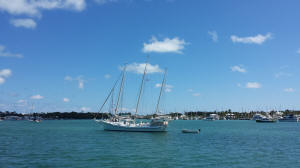 Marsh Harbor |
| Wintering in Marsh Harbor | |
|
My original plan for the Bahamas Cruise was to continue south
from the Abacos to Eleuthera or possibly the Exumas before
starting to head back to Florida in May.
So I ended up spending the next two months anchored in Marsh Harbor. |
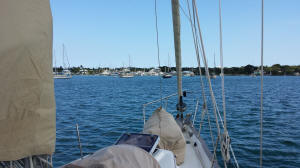 Marsh Harbor |
| During this period I was able get a good test of the soft shackles I prepared for the anchor chain snubber lines. During the month of March we had a number of very strong frontal passages. The shackles held with no sign wear through all of these storms. |
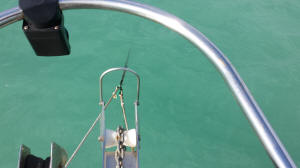 Two Snubber Lines Attached with Soft Shackles |
| I was able to solve the outboard motor problem. I was forced to replace my old tank while in Vero Beach. The new tank is shown on the right. This is one of the new ventless tanks mandated by the EPA. I'm not sure what the EPA thought was wrong with the old tanks, but as usual the new tank is a step backward in useablity. I discovered the outboard motor problem was a leaking fitting on the motor end of the fuel line. The fuel line is integral to the ventless feature of the tank, and a replacement was not available in the Bahamas. Rather than splice on a new fitting at the end of the fuel line, I elected to get rid of this workthless tank and the fuel line that cam with it. |
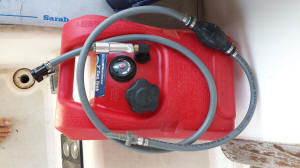 Fuel Tank Purchased in Vero Beach |
| For once having to replace a marine item while in the Bahamas was an advantage. I was out of the grasp of the EPA and could buy a conventional vented tank. This tank is shown in the picture on the right. No more outboard problems for the rest of my stay in the Bahamas. |
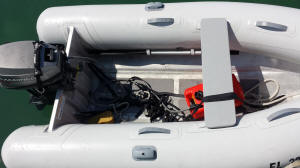 Fuel Tank Purchased in The Bahamas |
| After about a month at anchor with the dinghy in the water I had to haul the dinghy back on deck and clean the growth off the bottom. |
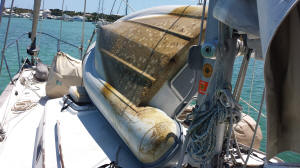 Dinghy Bottom After One Month in Water |
| I'm glad I didn't let the growth continue any longer than I did. It was fairly easy to remove the growth with a bunch of rags. |
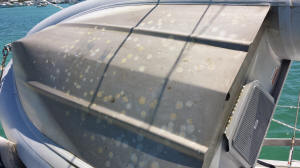 Dinghy Bottom After Cleaning |
|
One new problem was an impeller failure on the raw water
pump on the generator. While trying to replace the
impeller I dropped the cover plate and it rolled under fuel tank
where it is inaccessible. I took a few pictures of area where the cover fell hoping I would see it in an area I could reach it. As shown in the picture on the right, no joy there. |
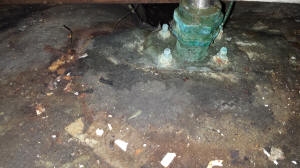 Searching for Lost Pump Cover Plate |
| Toward the end of April Steve was scheduled to rejoin me for the trip back to Florida. In preparation for our departure I moved Sarah back in the Harbor View Marina. |
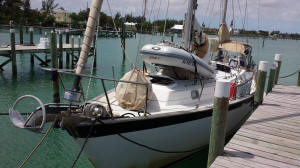 Berthed at Harbor View Marina |
|
By the time Steve
arrived I had purchased and received a new cover plate for the
sea water pump. With Steve's help I emptied the port
cockpit locker and climbed in to replace the worn impeller.
The pump and worn impeller are shown in the picture on the
right. I was able to install the new impeller and cover plate. However we were unable to remove the water hose between the pump and the heat exchanger because the lower hose clamp was pinned against the engine. Once the hose clamp was openned it could not be removed or reclosed. We started the generator and there was good water flow out the exhaust, but some water was leaking from the now unsecured hose. I remembered that I had this problem when installing this pump in 2009. I had attached the hose and clamps on the pump before installing it on the engine. I would need to do the same now. Instead we left the hose connection as is. The generator was useable with a slight water leak. One more thing to fix during the coming summer. |
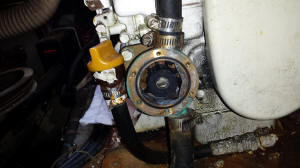 Generator Pump with Worn Impeller |
| Marsh Harbor to Jacksonville | |
|
For the return trip I wanted to avoid the AICW and sail direct
from the Abacos to the St. John River. The track of our
passage is shown on the right. Before departing the Abacos I forgot to check on the current eddies that are associated with the Gulf Stream. I thought there would be little chance of adverse currents as we would be sailing only a few miles off the Abacos and the Little Bahama Bank; however, we encounted a 2 kt. current shortly after entering the ocean from the North Man O'War channel. |
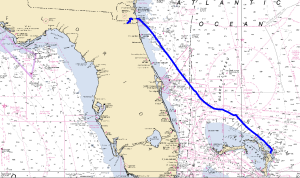 Sarah's Track From the Abacos to JAX |
|
This must have been a cold water eddy located east of the
Bahamas. This current slowed us to less than 5 kts for
most of the first day. During that first night we started
to move out of the current and eventually the next day we
started to get a boost from the Gulf Stream. On the right is satellite imagery of surface water temperatures on the day of our departure. I don't have the analysis skill or knowledge to determine what sort of eddies might have existed to the east and north of the Abacos. |
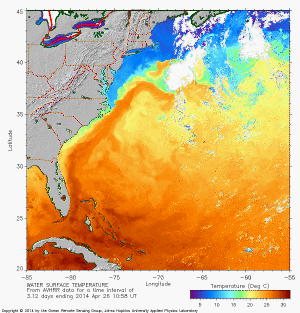 AVHRR merged 3-Day Surface Temperatures for the Perriod Ending on April 26, 2014 |
| We arrived off the St. John River on the morning of April 28 at the time of max ebb. As Steve often reminds me, we are always fighting either head winds or adverse currents. We motored slowly up the St. John and tied up at the Ortega Yacht Club Marina just before sunset. | |
| One part of this trip that worked really well was the Local Boater Option (LBO) and the Small Vessel Reporting Systme (SVRS) offered by the Customs and Border Protection (CBP). This allowed me to check-in on return from the Bahamas with a single telephone call. Unfortunately Steve did not have an LBO card and I had to drive him to the Homeland Security office in the port of Jacksonville the next day. | |
| So the trip did not work out as I had planned, but it was still a very pleasant winter. | |